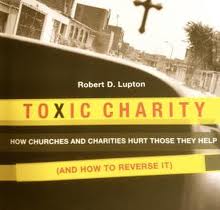 Churches and charities have fallen into the bad habit of creating programs to help the poor when in reality the only people they are helping are themselves, creating a toxic charity that needs to be reexamined and fixed.
Churches and charities have fallen into the bad habit of creating programs to help the poor when in reality the only people they are helping are themselves, creating a toxic charity that needs to be reexamined and fixed.
In a groundbreaking book, “Toxic Charity: HowChurches and Charities Hurt Those They Help (And How to Reverse It), Robert Lupton shows how good-intentioned people are actually hurting the very people they’re trying to help. The poor end up feeling judged, looked down upon, only worthy of charity and handouts that end up making them more dependent instead of learning skills to help themselves. Churches and charitable organizations, though good-intentioned, have missed the mark when it comes to serving the poor, creating a toxic form of charity. Lupton says that a better system would be to treat the poor as business partners, empowering them to start businesses, build houses, plan communities, etc. He offers specific organizations as examples of this healthier model of charity and gives practical ideas for how to get involved in service projects that truly help. Together, we can serve our world in a way that actually effects life-altering change.
The blog of the Sisters of Charity Foundation of South Carolina offers a review of the book and suggests looking at poverty differently.
“One often wonders about how to best serve the poor and marginalized in our communities. We wonder whether we are maximizing our resources to have lasting results. Recently, I met “Toxic Charity”
author
Robert Lupton at a meeting in Myrtle Beach, S.C. Lupton shed tremendous light on some of the concerns around serving the poor.
“At the
Sisters of Charity Foundation of South Carolina, we recognize a distinct separation between generational poverty and situational poverty, and how we address them both. We view generational poverty as chronic, with many variables that have caused a person to live in poverty, including family structure, community structure, educational attainment, access to health care, life skills, culture, value and attitudes. We view situational poverty as crisis poverty. A person is without food, clothing or shelter or in need of medical attention now but has no health insurance coverage. These two distinctions are very apparent and both are worthy of the Foundation’s attention and resources. In the Foundation’s case, more than 85% of our grant funding goes to addressing generational poverty. We feel we have greater impact in South Carolina addressing generational poverty, but we also realize that situational and crisis poverty exists and needs support.
“Lupton explained the dilemma faced with providing services through our government, churches and nonprofit organizations. Lupton believes, and I agree, that we often apply crisis tactics to chronic problems, even when the situation is clearly persistent. Applying crisis intervention to a chronic issue can be harmful to a person or a family and it fosters dependency, which perpetuates poverty. This is why people who are poor remain poor.
“The question becomes “what can we do differently?” Lupton feels the most important factor missing in most service programs for the poor is that the recipient has no “skin in the game.” You give them something the first time and they appreciate it. You give them something a second time and they anticipate it. You give them something a third time and they expect it. You give it a fourth time and they depend on it. If you really look closely at a person in poverty, odds are that they would much rather be a partner or participant than a charity case. That is why free clothes closets are not good but thrift stores work. That is why free food banks foster dependency but inexpensive food co-ops allow the person to become a customer.
“A lot of organizations are trying very hard to do the right thing for others. This is in no way to criticize the good intentions that organizations have or the work that they do.
“This is about looking at those we want to help, differently. This is about respecting the client and building their ability to be self sufficient. As Lupton said, “We never do for someone else what they are capable of doing for themselves.”
“Communities and organizations dealing with issues around poverty must be willing to shift. The United States gives away more food, money and services than any other country in the world. But rather than just giving it away, can we find new ways to partner or help individuals become more independent? If so, they will become respected and confident consumers with a greater sense of self worth. It will also create an environment where individuals are no longer viewed as “charity” and where chronic issues are addressed more strategically and more collegially.
Related
Tags:
Anti-poverty strategies,
Foundation,
Sisters of Charity,
Systemic change
 Churches and charities have fallen into the bad habit of creating programs to help the poor when in reality the only people they are helping are themselves, creating a toxic charity that needs to be reexamined and fixed.
Churches and charities have fallen into the bad habit of creating programs to help the poor when in reality the only people they are helping are themselves, creating a toxic charity that needs to be reexamined and fixed.

Excellent!! We all need to rethink our approach to helping others. thank you.
This related article was also interesting: http://fcsministries.org/blog/on-changing-an-institution/
Thrift shops work well because the person can buy what they need, not what someone else thinks they need.
Those donating the goods to the shop feel good too, as the things are still being used not just thrown away.